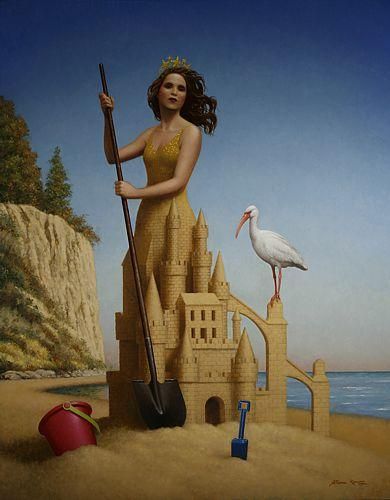
By Ellie Horton
Imagine a fair lady draped in a sparkling, gold gown with sun-kissed skin, rosy cheeks and elegant, copper hair whipped by the wind. Instead of a flowing train from the dress, picture a towering sand-kingdom fit for an empire of ants protruding beneath the lady’s waist. Yet, all if it is still somehow part of one anatomy. Pretty weird illustration, huh? It’s called surreal art, and the bewildering yet mesmerizing qualities of “The Sand Gown” were dreamed up by renowned surrealist artist, Steven Kenny.
Kenny resides in St. Petersburg and spends his days contriving fascinating paintings like “The Sand Gown.” A native of Peeksville, N.Y., Kenny obtained a fine arts degree from the Rhode Island School of Design. However, a fascination of Spanish surreal artist Salvador Dali prompted Kenny to relocate to St. Petersburg so he could live near his idol’s surrealist works in the Dali Museum.
Surrealism is a cultural movement that began in the early 1920’s and is known for visual artistry and writing. According to an article from the website “The Art Story Modern Art Insight,” “Surrealist artists sought to channel the unconscious as a means to unlock the power of the imagination. Disdaining rationalism and literary realism, and powerfully influenced by psychoanalysis, the surrealists believed the rational mind repressed the power of imagination, weighting it down with taboos.”
Kenny’s own concoction of the phantasmal and realistic involves marrying humanity and nature. As a result, the surrealist works function on two levels. The level first alludes to humanity’s position in the natural world and its subjection to nature’s laws. Symbiotic relationships between people and earth are often captured in Kenny’s art. Depending on the perspective, that connection could be harmonious or dysfunctional. Secondly, Kenny taps into the emotional, intellectual and psychological landscapes of nature by peering into self-exploration and discovery.
“Kenny imbues his work with an eerie consciousness of humankind’s simultaneous placement within and displacement from the natural world. The surreality of his work lies less in its weirdness than in the sheer difficulty of putting your finger precisely on what is weird about it,” Dr. H. Alexander Rich, director of the Melvin Gallery at FSC, said. “His worlds look surreal and we know they are surreal but it’s hard often to describe what is surreal about them. Basically, that’s the definition of surreal.”
As a surrealist, Kenny aims to create art in which viewers can find their own personal significance, making the art more universally understandable than other surrealist’s works, like Dali’s. Rich explains that Kenny’s art evokes emotion that all can relate to in regards to humanity’s place in the natural and manmade worlds.
Coming at the end of January, Florida Southern students can find their own affinity with Kenny’s masterpieces at the “Manifest Content: The Mysterious Art of Steven Kenny” exhibition at the FSC Melvin Gallery. The show opens on Jan. 20 at 7 p.m. and will be showcased through Feb. 24.
While this type of art can easily baffle the viewer, Rich encourages Florida Southern students to have fun when examining the beguiling pieces. He says that Kenny’s work is very accessible, causing any deciphers of the juxtapositions between humans and nature to all be valid. Kenny’s pieces can resonate with every student on a basic human and psychological level as long as they take the time to consider what is being conveyed. “Art is meant to make you think,” Rich says. “Kenny’s work pushes us to do so.” It’s a great experience for art and non-art majors alike!
“I’m looking forward to this exhibition because of the high technical skill and unique subject matter,” Siobhan Buckley, a senior studio art major, said. “We have had many high caliber artists here, but this one is the first in a long time that is figurative based. Art isn’t always made for the viewer to decide, it’s usually made for them to listen, observe and process. Good art makes the viewer do that.”